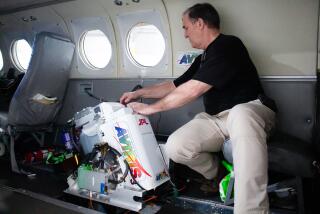Exhaust Measuring System Could Boost Electricity
LIVERMORE, Calif. â A new system that provides continuous information about the exhaust particles produced during combustion can help scientists design acceptable ways of generating electricity from coal, researchers say.
James Wang of Sandia National Laboratories in Livermore, where the system was developed, said test results indicate that it can provide the first reliable information without delays about the amount and size of particles inside a variety of combustion systems.
âThe system could be a key to successful commercialization of new ideas for generating electricity from coal since it can help determine whether designs are environmentally acceptable and energy efficient.â
It could also be useful in providing information about combustion effluents or airborne particles. Such data is critically needed in such areas as hospitals, microelectronics fabrication plants, foundries, gas turbines and inside hot gas cleanup equipment associated with most dirty fuel combustion systems, Wang said.
âThe ability to identify the size and amount of particulates in industrial combustion system gas and exhaust is critical, not only from the standpoint of controlling particle emissions, but also for process optimization and control,â Wang said.
âContinuous particle analysis in such systems would provide the opportunity to determine the effects of air and fuel delivery on the formation and entrainment of particulates and to develop the means to minimize particle accumulation.â
The particle-mass monitoring system collects particle samples in high-temperature, high-pressure combustion environments, sorts them according to size, determines the amounts of particulate matter present in a given volume and automatically cleans particle collectors for continuous operation.
âCurrent commercial particle detectors are either optical devices that do not measure particle mass directly or physical sampling devices that do not provide real-time measurements,â Wang said.
The new system, developed with funding from the U.S. Department of Energy, includes a device called a tapered element oscillating microbalance. It looks like a Champagne glass clamped at its mouth to a base plate. A filter is attached to the narrow end, which oscillates during operation between two electrically charged plates.
When in use, the element is inserted inside a combustion chamber so that gas or stack effluent samples must pass through it. As particles collect on its filter, it becomes heavier, causing the tip to oscillate at different frequencies.
The oscillation and particle accumulation are measured through fiber optic cables. The cables send messages to equipment that translates them into data about the amount of trapped particles.
Funnels, each of which traps particles in a certain size range, recently were installed upstream from the system. Scientists examine these funnels to get information about particle sizes.
The self-cleaning system dislodges trapped particles from the oscillating microbalanceâs filter with periodic puffs of air or gas that flow in a direction opposite to combustion products.
The system was developed as part of the Department of Energyâs hot gas cleanup program aimed at finding efficient ways to use fossil energy through direct combustion of coal, Wang said.





